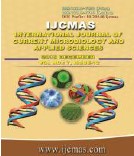


 National Academy of Agricultural Sciences (NAAS)
National Academy of Agricultural Sciences (NAAS)

|
PRINT ISSN : 2319-7692
Online ISSN : 2319-7706 Issues : 12 per year Publisher : Excellent Publishers Email : editorijcmas@gmail.com / submit@ijcmas.com Editor-in-chief: Dr.M.Prakash Index Copernicus ICV 2018: 95.39 NAAS RATING 2020: 5.38 |
Field experiments were conducted during 2015 & 2016 at Mountain Research Centre for Field Crops, Khudwani, SKUAST-Kashmir, India. Our objective was to measure the impact of alternative water management practices and varying N levels on water productivity, physiology, growth and yield of rice. Treatments comprised of three irrigation regimes; Submerged conditions (I1); Irrigation at 3 days after disappearance of ponded water (I2); Irrigation at 6 days after the disappearance of ponded water (I3) in main plots and four nitrogen doses viz., 0 kg/ha (N0); 80 kg/ha (N1); 100 kg/ha (N2); 120/kg ha (N3) in subplots. Results revealed that with I2 water management practice it is possible to simultaneously increase the yield and decrease the water requirements of irrigated rice significantly. I2 increased the grain yield by about 6% and 16% as compared to I1 and I3, respectively. Continuous submergence resulted in significant yield penalty and considerable wastage of water while as I3 condition created acute moisture deficit in the soil which finally translated into poor crop stand. The benefits of water saving in I3 condition were outweighed by significant decline in physiological performance, growth and yield of rice. The growth and yield of crop increased as the N dose was increased from N0 to N3. The yield gain in N1, N2 and N3 was 48%, 60% and 75% as compared to N0.
 |
 |
 |
 |
 |